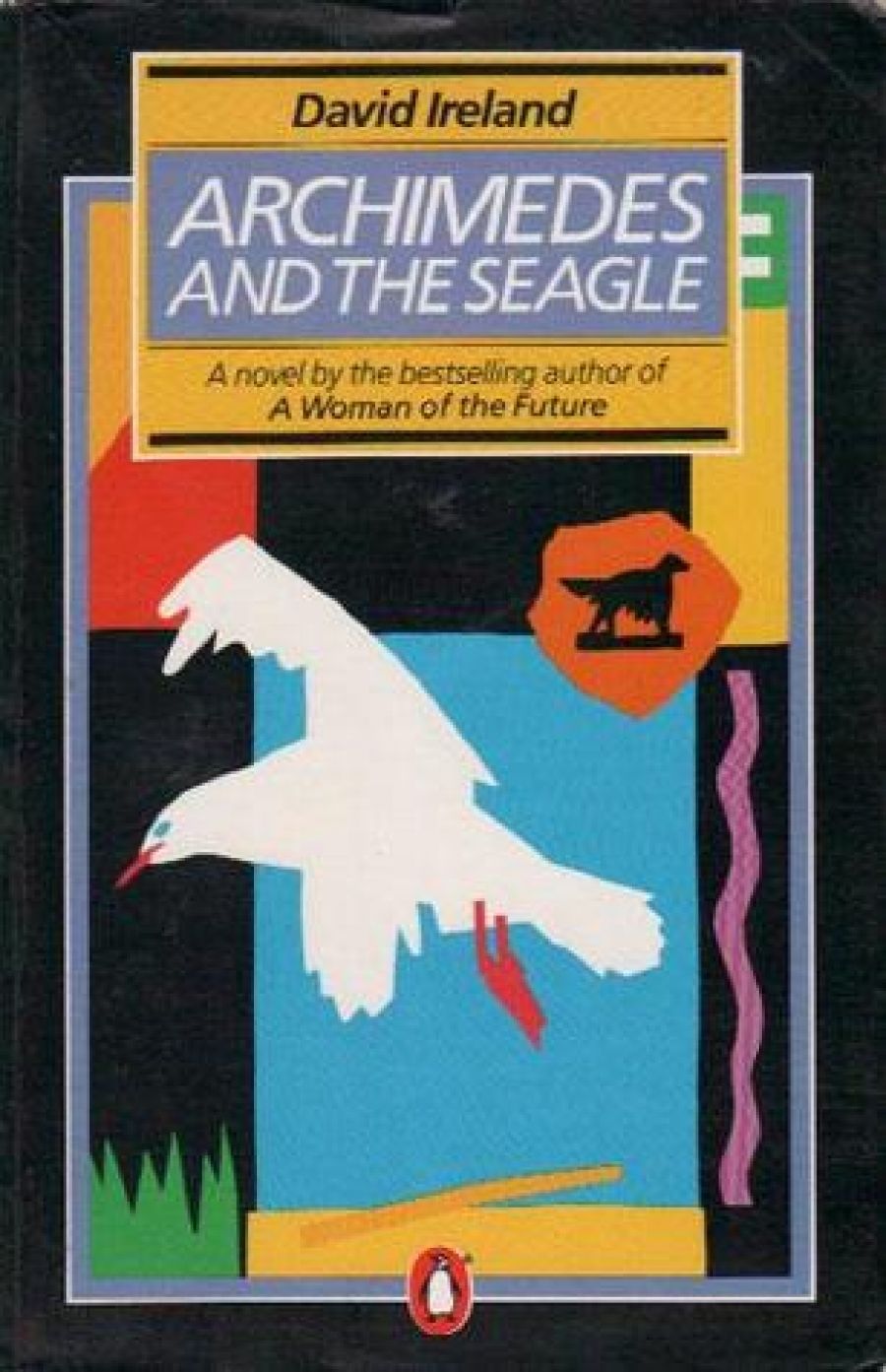
- Free Article: No
- Contents Category: Fiction
- Review Article: Yes
- Online Only: No
- Custom Highlight Text:
‘I wrote this book to show what dogs can do’, writes Archimedes the red setter in the preface to his book, and what follows are the experiences, observations, and reflections of a dog both ordinary and extraordinary. Archimedes’ physical life is constrained by his ‘employment’ with the Guests, an average Sydney suburban family – father, mother, and three children. He is taken for walks – the dog laws make unaccompanied walks too dangerous, he leaves his ‘messages’ in appropriate places, he knows the electricity poles intimately, and the dogs in his territory, Lazy Bill, Princess, Old Sorrowful Eyes, and Victor the bulldog.
- Book 1 Title: Archimedes and the Seagle
- Book 1 Biblio: Viking Press, $16.95, 228 pp
- Book 2 Title: Jane Austen in Australia
- Book 2 Biblio: Heinemann, $17.95, 332 pp
- Book 2 Cover Small (400 x 600):

Through Archimedes’ canine senses, Ireland powerfully evokes the environs of Sydney Harbour – Circular Quay, the Opera House, Hyde Park, The Rocks, but above all the sense of the sparkling water and the clear sky. This love of Sydney is a major strength of the novel.
The seagulls, constant inhabitants of the harbour-side city, carry much of the novel’s life and meaning. Gulls can talk, Archimedes discovers, and he witnesses a gull wedding, observes their constant squabbles over food scraps, and hears talk about the Tomb of the Unknown Seagull. Some gulls scorn to eat human scraps, and try to educate others to return to their traditional hunting and fishing. Parallels with human behaviour are obvious. As Archimedes says,
Much the same sorts of criticisms apply to seagulls, as to dogs and humans. They could be so much better, they could know and do far more; but they aren’t and they don’t.
This note of common sense is important. Archimedes’ criticisms of other creatures are accompanied by generosity and a sense of his own limitations.
While there may be much to criticise about seagulls, they can also fly, and Archimedes yearns for the freedom of flight. The supreme seagull is the seagle, a bird so powerful and solitary that it soars like an eagle:
My seagle has taken off into the wind, and as I watched, he held his wings outstretched and rode, up and up, taking the wind head-on. What a great flyer he was.
But the seagle is a disappointment. When Archimedes speaks to him he doesn’t answer – merely flies up high, and aloof. Archimedes realises that attractive as this freedom may be, his own destiny is with others – be they dogs or men.
Through Archimedes, Ireland shows his remarkable capacity to evoke the joy of movement, the warmth of sunshine, the feel of grass underfoot, and the textural changes of the air.
The dog’s eye view also allows him to present directly – almost in essay form – some of his own attitudes and concerns. In the chapter entitled ‘Gripes About Humans’, Archimedes catalogues the follies of the human world, armament races, wars, love of wealth, and adulation of leaders, but concludes: ‘I think Pangloss was right: this is the best world possible. All we have to do is improve it.’
Archimedes and the Seagle celebrates the pleasure of being alive, the enjoyment of natural and man-made beauty, companionship, and everyday wisdom. While it lacks the bite of earlier Ireland novels, it marks a coming to terms with those aspects of the world, and of our own natures, which we cannot change. It values all efforts to extend knowledge and seek new horizons.
IT IS STRANGE, is it not, that we are able to designate the inhabitants of this land only as natives and aborigines – words which might describe the primitive inhabitants of any country.
So remarks Jane Austen at a supper party of ham patties, cakes, and negus, in Parramatta circa 1803, and initiates some speculation on the possibility of ‘Australia’ as an appropriate name for the young colony.
It is a long way from the decorous world of Jane Austen’s novels to the raw colony of New South Wales, where Philip King has recently controlled the rum corps, and emancipated convicts are living like gentlemen, and it is the reader’s sense of this distance which provides the novel with an immediate fascination.
In 1800, an aunt of Jane Austen was tried for theft, and it is this aunt and her husband whom Jane accompanies to Australia after the aunt’s acquittal. Barbara Ker Wilson has skilfully woven into the novel detail of Jane Austen’s life – the fortunes of her family, her father’s death, the move to Bath, a possible romance, and authentic letters. In Australia she meets historical figures like Elizabeth McArthur, Matthew Flinders, Governor King, and the fascinating exhighwayman, D’Arcy Wentworth.
There are coincidences of Dickensian improbability, such as Jane’s meeting at Parramatta with the lover she had believed dead, and the novel is not recommended for solemn worshippers of Jane Austen. But if read as the author recommends ‘with indulgence and an appreciation of the humble spirit in which it was conceived’, the experiences of Jane Austen in Australia are entertaining reading.


Comments powered by CComment